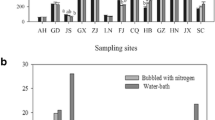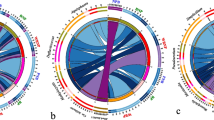Abstract
Purpose
Logistics and time demands necessitate soil storage under laboratory conditions after sampling because soil properties cannot always be determined immediately. There have been a number of studies about the effects of storage on biophysical properties; however, there has been little reference to paddy soils, which experience the alternation of wetting and drying phases. Our aims were to determine the impacts of sample storage on microbial activity and community structure in paddy field soil.
Materials and methods
We pre-incubated paddy soil to reach two states: flooded (F) and drained (D). Samples were then stored at −20 and 4 °C or air-dried. After 30 days, one part of the stored soils was used to measure key soil indices and the other part of the soil was incubated for 7 days prior to reassessment. Total phospholipid fatty acid (PLFA) was used to characterize the microbial biomass. MicroResp™ and Illumina next-generation sequencing techniques were adopted to analyze the change of microbial community activity and structure, respectively.
Results and discussion
Results showed that the various storage treatments did not affect the total PLFA in drained and flooded soil except for the flooded soil stored at 4 °C. Basal respiration was unusually increased in the drained soil after storage but recovered after a 7-day re-incubation. In contrast, the impact on flooded soils was minimal. Further, the soil community-level physiological profile (CLPP) was affected by storage, but microbial community structure remained mostly unchanged. Sequencing also showed that α diversity of the flooded paddy soil was higher than that in the drained soil.
Conclusions
The effect of storage on drained paddy soil using these indices was mainly consistent with previous studies on non-flooded cultivated soils, while the effect on flooded soil suggested a different mechanism from that in drained soil. Although the microbial function and community structure were different between drained and flooded paddy soils, the various storage approaches all altered the microbial functional structure to some extent but kept the microbial community structure largely intact.





Similar content being viewed by others
References
Arnold J, Corre MD, Veldkamp E (2008) Cold storage and laboratory incubation of intact soil cores do not reflect in-situ nitrogen cycling rates of tropical forest soils. Soil Biol Biochem 40:2480–2483
Bossio DA, Scow KM (1995) Impact of carbon and flooding on the metabolic diversity of microbial communities in soils. Appl Environ Microbiol 61:4043–4050
Burton J, Chen C, Xu Z, Ghadiri H (2010) Soil microbial biomass, activity and community composition in adjacent native and plantation forests of subtropical Australia. J Soils Sediments 10:1267–1277
Campbell CD, Chapman SJ, Cameron CM, Davidson MS, Potts JM (2003) A rapid microtiter plate method to measure carbon dioxide evolved from carbon substrate amendments so as to determine the physiological profiles of soil microbial communities by using whole soil. Appl Environ Microbiol 69:3593–3599
Černohlávková J, Jarkovský J, Nešporová M, Hofman J (2009) Variability of soil microbial properties: effects of sampling, handling and storage. Ecotox Environ Saf 72:2102–2108
Chapman SJ, Campbell CD, Artz R (2007) Assessing CLPPs using MicroResp™. J Soils Sediments 7:406–410
Chin K-J, Hahn D, Hengstmann U, Liesack W, Janssen PH (1999) Characterization and identification of numerically abundant culturable bacteria from the anoxic bulk soil of rice paddy microcosms. Appl Environ Microbiol 65:5042–5049
Christensen S, Christensen BT (1991) Organic matter available for denitrification in different soil fractions: effect of freeze/thaw cycles and straw disposal. J Soil Sci 42:637–647
Christensen S, Tiedje JM (1990) Brief and vigorous N2O production by soil at spring thaw. J Soil Sci 41:1–4
Curiel Yuste J, Baldocchi D, Gershenson A, Goldstein A, Misson L, Wong S (2007) Microbial soil respiration and its dependency on carbon inputs, soil temperature and moisture. Glob Chang Biol 13:2018–2035
Dassonville F, Renault P (2002) Interactions between microbial processes and geochemical transformations under anaerobic conditions: a review. Agronomie 22:51–68
De Nobili M, Contin M, Mondini C, Brookes P (2001) Soil microbial biomass is triggered into activity by trace amounts of substrate. Soil Biol Biochem 33:1163–1170
Degens BP (1998) Decreases in microbial functional diversity do not result in corresponding changes in decomposition under different moisture conditions. Soil Biol Biochem 30:1989–2000
Edwards A, Cresser M (1992) Freezing and its effect on chemical and biological properties of soil. Adv Soil Sci 18:59–79
Findlay RH, King GM, Watling L (1989) Efficacy of phospholipid analysis in determining microbial biomass in sediments. Appl Environ Microbiol 55:2888–2893
Gonzalez-Quiñones V, Banning NC, Ballesta RJ, Murphy DV (2009) Influence of cold storage on soil microbial community level physiological profiles and implications for soil quality monitoring. Soil Biol Biochem 41:1574–1576
Guo YJ, Di HJ, Cameron KC, Li B (2014) Effect of application rate of a nitrification inhibitor, dicyandiamide (DCD), on nitrification rate, and ammonia-oxidizing bacteria and archaea growth in a grazed pasture soil: an incubation study. J Soils Sediments 14:897–903
Haldeman DL, Amy PS, White DC, Ringelberg DB (1994) Changes in bacteria recoverable from subsurface volcanic rock samples during storage at 4 °C. Appl Environ Microbiol 60:2697–2703
Han P, Li M, Gu J-D (2013) Biases in community structures of ammonia/ammonium-oxidizing microorganisms caused by insufficient DNA extractions from Baijiang soil revealed by comparative analysis of coastal wetland sediment and rice paddy soil. Appl Microbiol Biotechnol 97:8741–8756
Hengstmann U, Chin K-J, Janssen PH, Liesack W (1999) Comparative phylogenetic assignment of environmental sequences of genes encoding 16S rRNA and numerically abundant culturable bacteria from an anoxic rice paddy soil. Appl Environ Microbiol 65:5050–5058
Huang J, Sheng X, He L, Huang Z, Wang Q, Zhang Z (2013) Characterization of depth-related changes in bacterial community compositions and functions of a paddy soil profile. FEMS Microbiol Lett 347:33–42
Kimura M, Asakawa S (2006) Comparison of community structures of microbiota at main habitats in rice field ecosystems based on phospholipid fatty acid analysis. Biol Fertil Soils 43:20–29
Kohler J, Knapp BA, Waldhuber S, Caravaca F, Roldán A, Insam H (2010) Effects of elevated CO2, water stress, and inoculation with Glomus intraradices or Pseudomonas mendocina on lettuce dry matter and rhizosphere microbial and functional diversity under growth chamber conditions. J Soils Sediments 10:1585–1597
Lauber CL, Zhou N, Gordon JI, Knight R, Fierer N (2010) Effect of storage conditions on the assessment of bacterial community structure in soil and human-associated samples. FEMS Microbiol Lett 307:80–86
Lee YB, Lorenz N, Dick LK, Dick RP (2007) Cold storage and pretreatment incubation effects on soil microbial properties. Soil Sci Soc Am J 71:1299–1305
Liesack W, Schnell S, Revsbech NP (2000) Microbiology of flooded rice paddies. FEMS Microbiol Rev 24:625–645
Liu Y, Yao H, Huang C (2009) Assessing the effect of air-drying and storage on microbial biomass and community structure in paddy soils. Plant Soil 317:213–221
Lüdemann H, Conrad R (2000) Molecular retrieval of large 16S rRNA gene fragments from an Italian rice paddy soil affiliated with the class Actinobacteria. Syst Appl Microbiol 23:582–584
McLamore E, Garland J, Mackowiak C, Desaunay A, Garland N, Chaturvedi P, Taguchi M, Dreaden K, Catechis J, Ullman J (2014) Development and validation of an open source O2-sensitive gel for physiological profiling of soil microbial communities. J Microbiol Methods 96:62–67
Morrissey EM, Gillespie JL, Morina JC, Franklin RB (2014) Salinity affects microbial activity and soil organic matter content in tidal wetlands. Glob Chang Biol 20:1351–1362
Noll M, Matthies D, Frenzel P, Derakshani M, Liesack W (2005) Succession of bacterial community structure and diversity in a paddy soil oxygen gradient. Environ Microbiol 7:382–395
Pesaro M, Widmer F, Nicollier G, Zeyer J (2003) Effects of freeze–thaw stress during soil storage on microbial communities and methidathion degradation. Soil Biol Biochem 35:1049–1061
Renault P, Ben-Sassi M, Bérard A (2013) Improving the MicroResp™ substrate-induced respiration method by a more complete description of CO2 behavior in closed incubation wells. Geoderma 207:82–91
Rissanen AJ, Kurhela E, Aho T, Oittinen T, Tiirola M (2010) Storage of environmental samples for guaranteeing nucleic acid yields for molecular microbiological studies. Appl Microbiol Biotechnol 88:977–984
Ross D (1991) Microbial biomass in a stored soil: a comparison of different estimation procedures. Soil Biol Biochem 23:1005–1007
Rubin BE, Gibbons SM, Kennedy S, Hampton-Marcell J, Owens S, Gilbert JA (2013) Investigating the impact of storage conditions on microbial community composition in soil samples. PLoS One 8:e70460
Saul-Tcherkas V, Steinberger Y (2009) Substrate utilization patterns of desert soil microbial communities in response to xeric and mesic conditions. Soil Biol Biochem 41:1882–1893
Shishido M, Chanway C (1998) Storage effects on indigenous soil microbial communities and PGPR efficacy. Soil Biol Biochem 30:939–947
Stenberg B, Johansson M, Pell M, Sjödahl-Svensson K, Stenström J, Torstensson L (1998) Microbial biomass and activities in soil as affected by frozen and cold storage. Soil Biol Biochem 30:393–402
Tatangelo V, Franzetti A, Gandolfi I, Bestetti G, Ambrosini R (2014) Effect of preservation method on the assessment of bacterial community structure in soil and water samples. FEMS Microbiol Lett 356:32–38
Tian J, Dippold M, Pausch J, Blagodatskaya E, Fan M, Li X, Kuzyakov Y (2013) Microbial response to rhizodeposition depending on water regimes in paddy soils. Soil Biol Biochem 65:195–203
Wakelin S, Lombi E, Donner E, MacDonald L, Black A, O’Callaghan M (2013) Application of MicroResp™ for soil ecotoxicology. Environ Pollut 179:177–184
Wallenius K, Rita H, Simpanen S, Mikkonen A, Niemi R (2010) Sample storage for soil enzyme activity and bacterial community profiles. J Microbiol Methods 81:48–55
Xu J, Peng S, Yang S, Wang W (2012) Ammonia volatilization losses from a rice paddy with different irrigation and nitrogen managements. Agric Water Manag 104:184–192
Xu H, Shun L, Jian-qiang S, San’an N, Valerie G, Hu L, Yong-guan Z (2014) Does urbanization shape bacterial community composition in urban park soils? A case study in 16 representative Chinese cities based on the pyrosequencing method. FEMS Microbiol Ecol 1:182–192
Yao H, Campbell CD, Qiao X (2011) Soil pH controls nitrification and carbon substrate utilization more than urea or charcoal in some highly acidic soils. Biol Fertil Soils 47:515–522
Acknowledgments
This work was financially supported by the Strategic Priority Program of the Chinese Academy of Science (Grant No.XDB15020300), the National Natural Science Foundation of China (Grant No.41090283 and 31272256), and the Natural Science Foundation of Ningbo (Grand NO. 21013A610185). We thank Prof. Yongguan Zhu for providing paddy soils and Chang Shuai for instructing using QIIME 1.7. We are grateful to Prof. Brajesh Singh and two anonymous reviewers for many insightful suggestions and valuable comments on the earlier version.
Author information
Authors and Affiliations
Corresponding author
Additional information
Responsible editor: Weijin Wang
Rights and permissions
About this article
Cite this article
Wang, J., Chapman, S.J. & Yao, H. The effect of storage on microbial activity and bacterial community structure of drained and flooded paddy soil. J Soils Sediments 15, 880–889 (2015). https://doi.org/10.1007/s11368-014-1053-7
Received:
Accepted:
Published:
Issue Date:
DOI: https://doi.org/10.1007/s11368-014-1053-7




